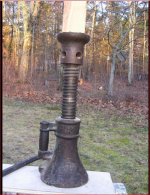Interesting. In New England people claim the Mayflower while here they claim Cherokee blood, even though the the ones around here were mostly Osage.
Bill
A little off topic, but in the 1980s "Yankee Magazine" did an article about the "dilution of genetics."
Back after the Revolutionary War, it became a "fad" to have been connected somehow to the Nation's Founders - perhaps this a luxury of being a "winner" - that is besides getting to write the history books? Similarly, to build on "connection" came the "Sons of the Revolution" (SAR) and the "Daughters of the Revolution" (DAR) You had to have a blood kin living or dead who had a connection to the Revolutionary Army. Membership in either of these held a certain social "cachet" and like all social clubs, those who were members somehow thought themselves somehow "more special?"
That is a human trait - form a club and make entrance hurdle just selective enough to keep the "riff-raff" out?
As was explained in the article, in the 1980 world, the SAR had sort of "petered out" with a decline in membership, numbers of activities, competition with an existing social cachet of men as "breadwinner," not to mention competition in the early 20th century with other "men's clubs" and our modern lifestyle. The social cachet for the SAR was effectively lost as men found other amusements, and increasing roles elsewhere socially.
Meanwhile, the DAR was still going strong as women had generally less social outlets - although by the 1980s their bread-winning diversion had also increased - but so had their potential membership.
As the article explained, with each generation the numbers of people who can claim to be "connected" to a Revolutionary War participant increases by a multiplication factor of two. Eventually given genetic mixing, EVERYONE will have a connection to the American Revolutionary War - and US residents who don't have this connection will be the exception. Talk about death to social cachet! If you can't be special - why bother trying?
The article then brought that thought a step further and opined that in about 10 generations, the genetic diversity of intermarriage outweighs any original trait or transmission, simply on the basis of generalized adoption within the population. A successful trait in 10 generations tends to be transferred to all (with a corresponding decrease in social cachet) and an unsuccessful trait tends to die out before any social cachet can be formed in the first place.
Also exampled was the fact that the organization "Sons and Daughters of the Pilgrims" was, after about 14 generations, almost universal in their membership acceptance. Less than 3 percent who apply are rejected - although this may follow more to the interest of those who seek admission. Their organizational social cachet is LONG GONE. It is very difficult today to find anyone who is NOT connected to the Pilgrims.
Of course I spoke earlier about having much of my genetic make-up having come over on the Mayflower. Perhaps I should not mention that my last name was the surname of 40 percent of the population Bridgewater, MA (from where I originate) in 1840? It was a small town then with limited betrothal choice. I have a lot of "repeats" on my family tree (i.e. sign of intermarriage within family.)
Joe in NH






